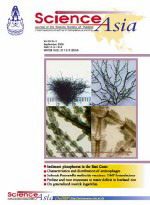ThaiScience
ThaiScience
SCIENCE ASIA
Volume 46, No. 05, Month OCTOBER, Year 2020, Pages 557 - 567
Morphological study, production and cryopreservation of blastospores of entomopathogenic fungi
Lakkhana K. Wingfield
Abstract Download PDF
Entomopathogenic fungi have been known as potential candidates for insecticides and metabolite producers. The aims of this study were to investigate characteristic and development patterns of blastospores and to determine optimal culture conditions for blastospore production of entomopathogenic fungi in the genera Akanthomyces, Cordyceps, Hirsutella, Metarhizium, and Torrubiella. Production of blastospores was induced using Grace’s insect cell medium (GICM) supplemented with foetal bovine serum (FBS) except the genus Torrubiella. Out of 39 fungal isolates, 18 isolates could produce blastospores, most of them belonged to the genus Cordyceps. Observation on characteristics and formation of blastospores revealed that blastospores produced from all genera shared common characters and formation. However, some distinctive characters were observed in the genus Akanthomyces. Effects of culture media, types of inoculum and cultivating condition were examined for the production of highest numbers of blastospores (up to 107–108 blastospores/ml), revealing different requirements in each fungal isolate for the production of blastospores. Cryopreservation of blastospores revealed that freeze-drying method could be used to preserved blastospores of C. brongniartii, Hisutella sp. 02 and Metarhizium sp. 02 except A. pistillariiformis. This study is the first comprehensive investigation on development patterns of blastospores and factors underpinning effective culture conditions for blastospores production of the selected entomopathogenic fungi.
Keywords
entomopathogenic fungi, blastospores, cryopreservationSCIENCE ASIA
Published by : The Science Society of Thailand
Contributions welcome at : http://www.scienceasia.org/
